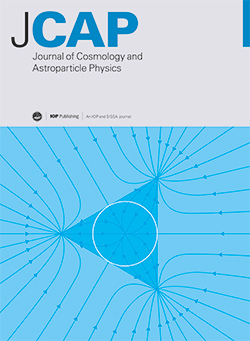Prospects for constraining interacting dark energy cosmology with gravitational-wave bright sirens detected by future FAST/SKA-era pulsar timing arrays
IF 5.3
2区 物理与天体物理
Q1 ASTRONOMY & ASTROPHYSICS
Journal of Cosmology and Astroparticle Physics
Pub Date : 2025-04-23
DOI:10.1088/1475-7516/2025/04/068
引用次数: 0
Abstract
We explore the constraints on cosmological parameters in interacting dark energy (IDE) models with energy transfer rates Q = βH ρde and Q = βH ρc, using simulated gravitational-wave (GW) bright sirens data from pulsar timing array (PTA) and Planck 2018 cosmic microwave background (CMB) data. By incorporating the mock PTA data from future observations in the FAST/SKA era, we demonstrate significant improvements on the constraint precision of key cosmological parameters such as the Hubble constant H0, matter density Ωm, and the coupling parameter β. In the IDE model with Q = βH ρde, PTA data could provide tighter constraints on these parameters than CMB data, particularly due to the high sensitivity of GW standard sirens in probing the late universe. Combination of PTA and CMB data could lead to the constraint improvements of 37.4% for H0, 37.4% for Ωm, and 36.1% for β, compared to the case using CMB data alone. In contrast, for the IDE model with Q = βH ρc, the CMB data alone could provide tighter constraints on ρ compared with PTA data, due to the stronger effect of CMB in the early universe. Combination of PTA and CMB data still yields constraint improvements of 17.6% for H0, 24.3% for Ωm and 17.4% for β compared to the case using CMB data alone. With the increase of the number of millisecond pulsars (MSPs), the constraints on all parameters for both IDE models can be further enhanced. Our results highlight the potential of future PTA observations to significantly improve the cosmological parameter estimation in IDE models, offering crucial insights into the nature of dark energy and the interaction between dark sectors.利用未来 FAST/SKA 时代脉冲星定时阵列探测到的引力波亮警报器制约相互作用暗能量宇宙学的前景
利用脉冲星定时阵列(PTA)的模拟引力波(GW)亮信号数据和普朗克2018宇宙微波背景(CMB)数据,探讨了能量传输速率为Q = βH ρde和Q = βH ρc的相互作用暗能量(IDE)模型中宇宙学参数的约束。通过结合FAST/SKA时代未来观测的模拟PTA数据,我们证明了哈勃常数H0、物质密度Ωm和耦合参数β等关键宇宙学参数的约束精度有了显着提高。在Q = βH ρde的IDE模型中,PTA数据比CMB数据提供更严格的参数约束,特别是由于GW标准警报器在探测晚期宇宙时的高灵敏度。与单独使用CMB数据相比,PTA和CMB数据的结合可以使H0的约束改善37.4%,Ωm的约束改善37.4%,β的约束改善36.1%。相比之下,对于Q = βH ρc的IDE模型,由于CMB在宇宙早期的作用更强,单独的CMB数据比PTA数据能提供更严格的ρ约束。与单独使用CMB数据相比,PTA和CMB数据的结合仍然可以使H0的约束改善17.6%,Ωm的约束改善24.3%,β的约束改善17.4%。随着毫秒脉冲星(msp)数量的增加,两种IDE模型对所有参数的约束都可以进一步增强。我们的研究结果强调了未来PTA观测的潜力,以显着改善IDE模型中的宇宙学参数估计,为暗能量的本质和暗扇区之间的相互作用提供了重要的见解。
本文章由计算机程序翻译,如有差异,请以英文原文为准。
求助全文
约1分钟内获得全文
求助全文
来源期刊

Journal of Cosmology and Astroparticle Physics
地学天文-天文与天体物理
CiteScore
10.20
自引率
23.40%
发文量
632
审稿时长
1 months
期刊介绍:
Journal of Cosmology and Astroparticle Physics (JCAP) encompasses theoretical, observational and experimental areas as well as computation and simulation. The journal covers the latest developments in the theory of all fundamental interactions and their cosmological implications (e.g. M-theory and cosmology, brane cosmology). JCAP''s coverage also includes topics such as formation, dynamics and clustering of galaxies, pre-galactic star formation, x-ray astronomy, radio astronomy, gravitational lensing, active galactic nuclei, intergalactic and interstellar matter.
 求助内容:
求助内容: 应助结果提醒方式:
应助结果提醒方式:


